Mohamedsbkamara
On this page, you find all documents, package deals, and flashcards offered by seller mohamedsbkamara.
- 49
- 0
- 1
Community
- Followers
- Following
50 items
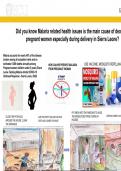
poster on malaria prevention
Pregnant women are the most at risk for malaria infection. An estimated 11 million out of 38 million (29%) pregnancies in sub-Saharan Africa, where moderate to high malaria transmission happens, were exposed to the disease in 2018 ("World Malaria Report 2022," n.d.). P. falciparum infection during pregnancy, though frequently silent, is linked to undesirable pregnancy outcomes like stillbirth, low birth weight (LBW), preterm delivery, abortion, and maternal anemia.
- Other
- • 1 pages •
Pregnant women are the most at risk for malaria infection. An estimated 11 million out of 38 million (29%) pregnancies in sub-Saharan Africa, where moderate to high malaria transmission happens, were exposed to the disease in 2018 ("World Malaria Report 2022," n.d.). P. falciparum infection during pregnancy, though frequently silent, is linked to undesirable pregnancy outcomes like stillbirth, low birth weight (LBW), preterm delivery, abortion, and maternal anemia.

Malaria disease
According to the World Health Organization’s (WHO), 2019 periodic global malaria report, there were 229 million cases of malaria and 409,000 fatalities in 87 countries with malaria. Since 2000, there have been a total of 9 million fewer cases (Programme, 2015). According to the most current WHO statistics, there were 824 malaria-related deaths in Sierra Leone in 2020, or 11.25% of all fatalities. With a death rate of 61.60 per 100,000 people, Sierra Leone has the highest age-adjusted mortal...
- Package deal
- Other
- • 11 pages •
According to the World Health Organization’s (WHO), 2019 periodic global malaria report, there were 229 million cases of malaria and 409,000 fatalities in 87 countries with malaria. Since 2000, there have been a total of 9 million fewer cases (Programme, 2015). According to the most current WHO statistics, there were 824 malaria-related deaths in Sierra Leone in 2020, or 11.25% of all fatalities. With a death rate of 61.60 per 100,000 people, Sierra Leone has the highest age-adjusted mortal...
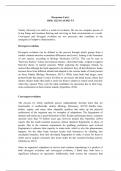
Variety (diversity) on earth is a result of evolution
Variety (diversity) on earth is a result of evolution. We can see complex species of living things and creatures thriving and surviving in their environments as a result. Convergent and divergent evolution are two processes that contribute to the emergence of adaptive characteristics.
- Other
- • 2 pages •
Variety (diversity) on earth is a result of evolution. We can see complex species of living things and creatures thriving and surviving in their environments as a result. Convergent and divergent evolution are two processes that contribute to the emergence of adaptive characteristics.
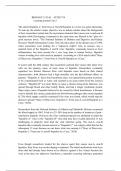
It wasn't until the 20th century that researchers realized that viruses that infect liver cells are the primary cause of most cases of hepatitis
The article Hepatitis C: from Non-A, Non-B Hepatitis to a Cure was quite interesting. To sum up, the article's major objective was to inform readers about the background of how researchers looked into the mysterious chemical that causes non-A and non-B hepatitis while Developing a treatment at the same time was likened to the "plot of a good mystery novel. "The National Institute of Diabetes and Digestive and Kidney Diseases' Health Information Center. This tale takes place in the distant ye...
- Package deal
- Other
- • 2 pages •
The article Hepatitis C: from Non-A, Non-B Hepatitis to a Cure was quite interesting. To sum up, the article's major objective was to inform readers about the background of how researchers looked into the mysterious chemical that causes non-A and non-B hepatitis while Developing a treatment at the same time was likened to the "plot of a good mystery novel. "The National Institute of Diabetes and Digestive and Kidney Diseases' Health Information Center. This tale takes place in the distant ye...
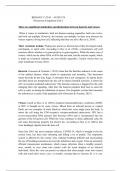
There are significant similarities and distinctions between bacteria and viruses
When it comes to similarities, both are disease-causing organelles, both can evolve, and both can multiply. However, the bacteria can multiply on their own whereas the viruses require a living host cell, indicating that they are alive (Rye et al, 2016). Their variations include; Prokaryotes known as bacteria have fully developed round, rod-shaped, or spiral cells. According to Rye et al. (2016), a bacterium's cell wall structure affects whether it is gram-positive or gram-negative. While th...
- Package deal
- Other
- • 2 pages •
When it comes to similarities, both are disease-causing organelles, both can evolve, and both can multiply. However, the bacteria can multiply on their own whereas the viruses require a living host cell, indicating that they are alive (Rye et al, 2016). Their variations include; Prokaryotes known as bacteria have fully developed round, rod-shaped, or spiral cells. According to Rye et al. (2016), a bacterium's cell wall structure affects whether it is gram-positive or gram-negative. While th...
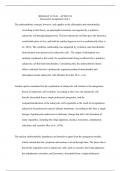
The endosymbiotic concept, however, only applies to the chloroplast and mitochondria.
The endosymbiotic concept, however, only applies to the chloroplast and mitochondria. According to this theory, an autotrophic bacterium was ingested by a primitive eukaryotic cell through phagocytosis. The host eukaryotic cell then gave the bacteria a comfortable place to live, and both the entities began to survive symbiotically (Rye et al., 2016). The symbiotic relationship was supported by evolution, and mitochondria from bacteria were preserved in eukaryotic cells. The origin of chloroplas...
- Package deal
- Other
- • 3 pages •
The endosymbiotic concept, however, only applies to the chloroplast and mitochondria. According to this theory, an autotrophic bacterium was ingested by a primitive eukaryotic cell through phagocytosis. The host eukaryotic cell then gave the bacteria a comfortable place to live, and both the entities began to survive symbiotically (Rye et al., 2016). The symbiotic relationship was supported by evolution, and mitochondria from bacteria were preserved in eukaryotic cells. The origin of chloroplas...
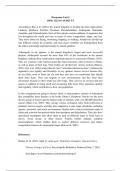
Arthropoda, in my opinion, is the animal kingdom's largest and most successful phylum.
According to Rye at al. (2016), the animal kingdom is divided into nine major phyla: Cnidaria, Mollusca, Porifera, Chordata, Platyhelminthes, Arthropoda, Nematoda, Annelida, and Echinodermata. Each of these phyla contains millions of organisms that live throughout the world and vary in terms of color, composition, shape, and size. They move about via flying, swimming, hopping, or walking. Animals are divided up into different classes by scientists, and each class's members are distinguished fro...
- Package deal
- Other
- • 2 pages •
According to Rye at al. (2016), the animal kingdom is divided into nine major phyla: Cnidaria, Mollusca, Porifera, Chordata, Platyhelminthes, Arthropoda, Nematoda, Annelida, and Echinodermata. Each of these phyla contains millions of organisms that live throughout the world and vary in terms of color, composition, shape, and size. They move about via flying, swimming, hopping, or walking. Animals are divided up into different classes by scientists, and each class's members are distinguished fro...
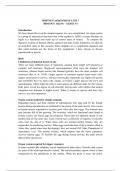
Animal structure and function
We have found that even the simplest species are very complicated. An organ system is a group of anatomical structures that work together to fulfill a certain function; an organ is a functional unit made up of various types of tissues. To compare the digestive systems of humans (Homo sapiens) and dogs (Canis familiaris), we shall do an analytical study in this research. Since dolphins are a complicated organism and that small animals are the focus of this assignment; I have chosen to discuss r...
- Package deal
- Other
- • 3 pages •
We have found that even the simplest species are very complicated. An organ system is a group of anatomical structures that work together to fulfill a certain function; an organ is a functional unit made up of various types of tissues. To compare the digestive systems of humans (Homo sapiens) and dogs (Canis familiaris), we shall do an analytical study in this research. Since dolphins are a complicated organism and that small animals are the focus of this assignment; I have chosen to discuss r...
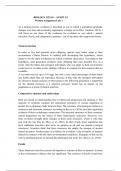
As a natural process, evolution is described as one in which a population gradually changes over time and eventually experiences a change in its DNA.
In order to live and generate more offspring, species must better adapt to their environment. Charles Darwin is credited with developing this hypothesis, which claims to be the main mechanism by which evolution takes place. According to this hypothesis, each generation produces more offspring than may possibly live; as a result, only the fittest and strongest individuals who can adapt to their environment would survive. In other words, siblings will have to compete for the resources that are ava...
- Package deal
- Other
- • 3 pages •
In order to live and generate more offspring, species must better adapt to their environment. Charles Darwin is credited with developing this hypothesis, which claims to be the main mechanism by which evolution takes place. According to this hypothesis, each generation produces more offspring than may possibly live; as a result, only the fittest and strongest individuals who can adapt to their environment would survive. In other words, siblings will have to compete for the resources that are ava...
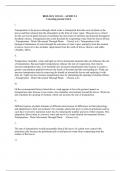
Temperature, humidity, wind, and light are all environmental elements that can influence the rate of transpiration.
Transpiration is the process through which water is transported from the roots of plants to the leaves and then released into the atmosphere in the form of water vapor. This process is critical for the survival of plants because it facilitates the movement of nutrients and minerals throughout the plant's tissues. Transpiration also cools the plant by evaporating water from the leaves (Home | Transpiration - Water Movement Through Plants - Passel, n.d.). Transpiration is the biological elimin...
- Package deal
- Other
- • 3 pages •
Transpiration is the process through which water is transported from the roots of plants to the leaves and then released into the atmosphere in the form of water vapor. This process is critical for the survival of plants because it facilitates the movement of nutrients and minerals throughout the plant's tissues. Transpiration also cools the plant by evaporating water from the leaves (Home | Transpiration - Water Movement Through Plants - Passel, n.d.). Transpiration is the biological elimin...
